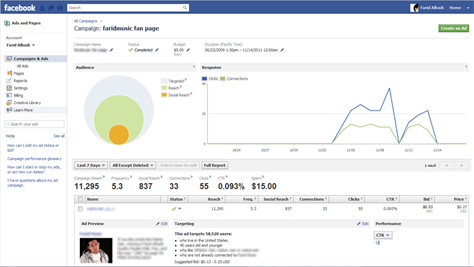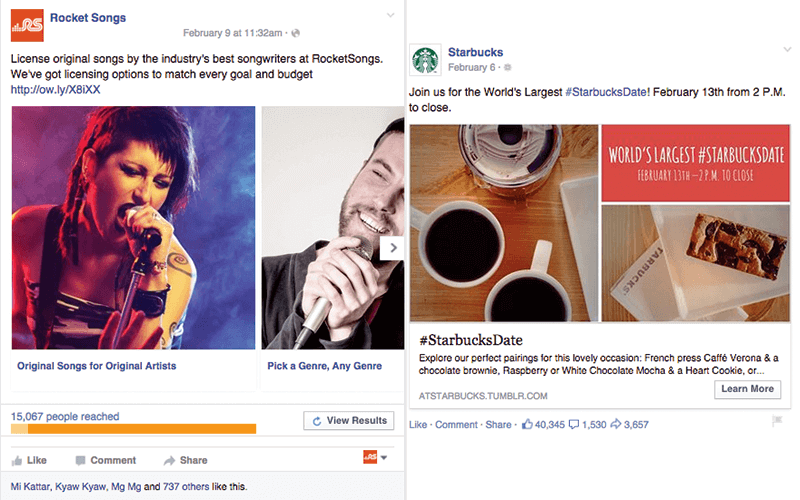While Instagram and Snapchat may seem like the “cooler” option for advertising nowadays, Facebook ads are still ruling the world of online marketing. In fact, Facebook is estimated to make more than $4 billion in revenue by the end of this year just from advertising.
So, how do you get clicks? This post will guide you through the ins-and-outs of Facebook advertising. You’ll learn which businesses are the best for Facebook marketing and how to run a successful campaign.
If you’re new to Facebook, you might want to start with this Facebook Marketing Guide. Once you’ve read it, circle back around for a deeper dive into advertising.
The Basics: How do Facebook Ads Work?
Facebook ads come in a variety of forms – you can promote a Page itself, the posts on a Page, your website, or actions taken by a user. Despite Facebook’s focus on native ads and sustaining web traffic, you can still successfully send users to your website using Facebook ads.
Facebook ads target users based on their location, demographic, and profile information. Once you create an ad, you can set a budget and bid for either each click or thousand impressions that your ad receives. Your ad will then be displayed in the sidebar on Facebook for everyone to see.
While Facebook’s other ad options are great for brand awareness and driving engagement, ads that drive users off-site are the best option for direct response advertisers looking to make a sale.

Who Should Use Facebook Advertising?
Many businesses bomb when it comes to Facebook ads simply because their business isn’t a good fit. Before using a new marketing channel, it’s a good idea to test it first. Think of your business model and how (or if) it fits the network.
Facebook ads are display ads, not search ads. They’re used to generate demand, rather than fulfill an actual need. Essentially, Facebook users are online to connect with friends, not to find products to buy.
Low-Friction Conversions
Businesses that succeed with Facebook ads ask users to “sign up,” not buy. In order to be successful, you must use a low-friction conversion.
If you sell products instead of services, you should focus on an intermediate conversion like a newsletter signup. Then you can utilize email marketing in addition to Facebook advertising.
Sites like AppSumo, Groupon, and Fab are great examples of businesses that have been successful with Facebook advertising. Once you click on their ad, they’ll ask for an email address, and presto! The user is sold on a deal later on.
Business Model
Even if you’re only asking for an email address initially, you’ll eventually need to make money from your users if you want your ads to be profitable. The best business model suited to Facebook ads is to earn revenue over a long period of time, instead of all at once. While a user may give you their email address, you’ll still need to build a little bit of trust before you can expect them to buy something.
Don’t depend on one large purchase; instead, hope that he or she makes several smaller purchases.
Daily deal and subscription sites are good examples of business models that thrive on Facebook: Both have customers whose lifetime value is spread out over six months or more.
How to Target Your Ad
One of the biggest mistakes marketers make with Facebook ads is not targeting them correctly.
Facebook’s ad targeting options are unparalleled. You can target users by:
- Workplaces
- Location
- Gender
- Age
- Interests
- Languages
- Education
- Connections
- Relationship status
Each option can be useful, depending on your audience. However, most marketers should focus on age, location, gender, and interests.
Images
The most important part of a Facebook ad is the image. You can write amazing copy, but if your image is dull, you’ve wasted your time.
Image tips:
- Avoid low-quality images
- Ensure you can use the image (i.e. don’t steal an image from Google or anyone/where else)
- Do not use your logo, unless you’re a famous brand
Now that you know what not to do, here’s a quick list of what you should do:
- Buy an image to use
- Create your own image
- Take advantage of Creative Commons

Facebook Ad Copy
After seeing your image, users should be compelled to read your ad text. This is where you can sell them on your service or product and earn their click.
Despite the 25 character headline and 90 character body text limit, you can still use the famous copywriting formula AIDA – Attention, Interest, Desire, Action.
Attention: Draw users in with an attention-grabbing headline.
Interest: Get users interested in your product by briefly describing the benefit of using it.
Desire: Create desire with a free trial, discount, or limited-time offer.
Try writing 5-10 ads until you’re able to hone in on the perfect version.
Bidding on Facebook Ads
Bidding can mean the difference between profit and failure. Once you’ve created your ad, Facebook will provide a suggested bid range. If you’re just starting out, you should set your bid near the lower end of the range.
Your CTR will dictate the price you’ll need to pay for traffic. If this number is high, your suggested bid price will decrease. If it is low, you’ll need to bid more for each click.

Tracking Your Performance
Facebook no longer offers conversion tracking, but Facebook Insights are great to track how your users are behaving within Facebook. To track users once they’ve left the site, you’ll need to use an outside analytics program like Google Analytics. Tag your links using Google’s URL builder or your own tracking tags.
Conclusion
Facebook is one of the best marketing tools out there. Just remember to target specific interests, use high-quality images, and give users a low-friction conversion.
After a week or two of trial and error, you’ll begin to see what works (and what doesn’t) for your business.










